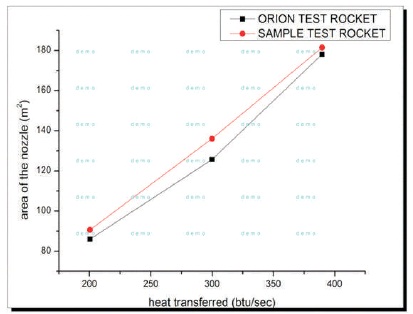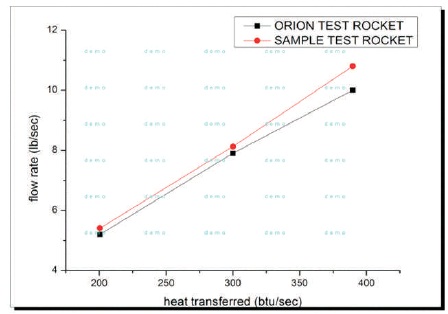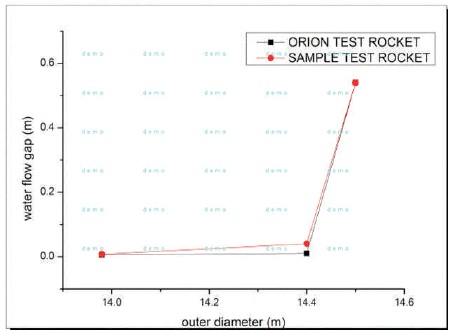Figure 1. Calorific Value of Fuels
The manuscript demonstrates the designing of a first stage rocket engine using butane as a fuel and liquid oxygen as the oxidizer combination for yielding higher values of heat of combustion, Mach number, specific Impulse and the exit velocity through the nozzle. The purpose of this research is to provide a fuel oxidizer combination whose heat of combustion would be much higher. With a higher calorific value of butane, it needs very little oxidizer to burn resulting in reducing the weight of the rocket. Chemical Experimental Analysis has shown that the calorific value of butane and liquid oxygen together will yield much higher values in comparison to that of the present combination of fuel and oxidizers. The research paper analyses the design calculations of the space shuttle engine; Solid Works Design of complete Rocket Engine; comparative study of the model rocket with the Orion test rocket; CFD analysis of Rocket Engine.
The purpose of research in the space industry is to develop efficient vehicles or engines either by introducing new combination of chemical propellants or new propulsion thrusters. However, the research related to chemical propellants has by far been most successful. In the recent years, reducing the fuel and oxidizer content or increasing fuel's efficiency, has been the prime motive. The same approach has been adopted in this research to inculcate the advantages of reacting butane which is a highly inflammable liquefied gas with liquid oxygen. The reaction has been conducted to harness higher values of heat combustion, Mach Number, Specific Impulse, Pressure Ratio and Thrust, approximately twice to that of the conventional combination of propellants. The research was performed in a bomb calorimeter at Heat and Mass Transfer Laboratory at Institute of Engineering and Management, Kolkata which has yielded results convincing the future of its application.
Until now several research studies have been done in the field of design of rocket engines with better fuels and oxidizers for increasing its specific impulse time and overall thrust. For example, Ribert et al. (2008); Bainbridge and Horton (1971); Pohl, Jarczyk, Pfitzner, and Rogg (2013) studied on how the choice of propellants can enable the rocket engine to achieve better results in terms of propulsion and specific impulse. Other studies performed by Westbrook, Mizobuchi, Poinsot, Smith, and Warnatz (2005); Haidn and Habiballah (2003); Haidn (2008); Georgiadis, DalBello, Trefny, and Johns (2006) studied on the flow analysis patterns of change when different fuel and oxidizers are used for propulsion. In contrast to chemical propulsion, research in electric propulsion has also been done in nano-satellites like the ones potrayed by Kim (2003); Murphy, Kanaber, and Koehler (2011), Lim et al. (2015); Geeroms et al. (2005); Young, Burt, Watson, and Zollinger (2009); Mehrparvar et al. (2014); Kestila et al. (2013); Smith et al. (2011); Aherne, Barrett, Hoag, Teegarden, and Ramadas (2011). The present research develops a similar background on how the propulsion can be improved by choosing the right amount of oxidizer and fuel.
Figure 1 from Engineering Toolbox indicates the calorific values of various fuels. Butane can be observed as topping the charts with the maximum calorific value. A higher calorific value indicates that a less amount of input energy would be required for the combustion or for obtaining the maximum heat of combustion. This indicates directly to the less amount of liquid oxygen requirement for complete combustion. The reduction in the liquid oxygen requirement for complete combustion implies that the overall mass of the engine decreases. The density of butane being higher than the present rocket propellants used such as the kerosene or RP-1 enables complete combustion which has comparatively lower molecular weight at the exhaust which indicates to better efficiency and performance of the engine thus leading to more thrust and exit velocity.





















The theoretical and practical values have been validated with its testing in the bomb calorimeter. The values obtained are presented in Table 1, and have been used in the calculations for designing the nozzle and other auxiliary parts of the engine.

Table 1. Input Parameters
The design of the combustion chamber solely depends on the design parameters which are at standard atmospheric pressures, illustrated in Table 2.

Table 2. Design Parameters
For a sample rocket of 100 kg, a testing is done for which the values calculated are listed in Table 3.

Table 3. Output Values for 100 kg Rocket Engine
The calculations formulated for first stage operation of the proposed rocket engine is given in Table 4.

Table 4. Calculations of Gas Properties
Now here, a table is formulated for the range of values of L*(Parameter for volume of the chamber required for complete combustion) and its corresponding values of Vc and At in Table 5.

Table 5. Relation between L* and Combustion Chamber Volume
Here, a new parameter, i.e., the Length of the combustion chamber which is denoted by Lc is used (For a small combustion chamber, the convergent volume is 1/10 times the volume of the cylindrical part of the chamber) in Table 6. Copper is used for the wall, as copper's q value is equal to 3, which fits perfectly for the use in the combustion-chamber. The combustion chamber wall should be thick enough for efficient welding and brazing.

Table 6. Relation between Length and Volume of Combustion Chamber
For copper, the working stress is 8000 psi according to standard values. To allow for additional stress and welding factors, the wall thickness needs to be around 1 m as an allowance.
Wall Thickness = 0.23m
Now for a certain set of values of L , surface areas are c obtained as given in Table 7.

Table 7. Relation between Length and Area of Combustion Chamber
The total heat transferred into the coolant is illustrated with respect to different cross sectional area in Table 8.

Table 8. Relation between the Area and Heat Produced
The cooling water flow rate can be calculated using a desired rise in the temperature rise of 40 degree Fahrenheit, as illustrated in Table 9.

Table 9. Relation between the Heat Generated and the Water Flow Rate
The annular flow passage between the combustion pressure wall and the outer wall must be sized so that the flow velocity of the cooling water is at least 322.7 m/sec.
The table illustrates the water flow rate with respect to the diameter of cross section in Table 10.

Table 10. Relation between the Water Flow Rate and Outer Wall Diameter
Water flow gap is calculated for different diameters which are illustrated by the Table 11. The water flow gap is an essential parameter while designing a rocket engine. The water flow gap determines the amount of cooling the engine will achieve during its operation. In first stage, the amount of heat generated in the nozzle walls in its exterior as well as interior is maximum due to large amount of atmospheric drag and higher rate of combustion. Too small a water flow gap would result in improper flow rate as the tubes or hose pipes themselves might undergo thermal expansion. Too large the gap, the cooling through conduction will not be efficient resulting in decrease in performance or efficiency of the engine.

Table 11. Relation between the Outer Wall Diameter and the Water Flow Gap
Flow area for fuel injection is illustrated while considering certain factors in Table 12.

Table 12. Flow Area of Fuel Injection
The injection holes for the flow of gaseous oxygen will be simple drilled orifices enough to sustain supersonic velocity. A number 75 drill can be used in making the holes for the injection purposes. The number of holes must exceed 1 to avoid combustion instability or delay. Factor of safety while calculating the cooling parameter: Too low gap between the cooling jacket and the combustion chamber wall may result in explosion in the valves due to extreme heating. Too high gap between the cooling jacket and the combustion chamber wall may result in absolute no cooling due to lack of convection. Here, it has been inferred through calculation that with the increase in the diameter of the outer jacket there is an increase in the gap between the coolant valve and the combustion chamber wall, which will result in perfect cooling. The oxidizer having higher specific heat will circulate throughout the combustion chamber wall absorbing heat and sending it to the radiators which will then expel out the heat into the outer atmosphere. The injection holes will be simple drilled orifices. These holes must not be so small that sonic velocity will be achieved, since this would result in a higher upstream pressure requirement to drive the required amount of oxygen through the orifices. The Figures 2-6 have been created in SolidWorks.

Figure 2. Fuel & Oxidizer Injection Cross Sectional Area

Figure 3. Cross Sectional Area of the Water Inlet

Figure 4. Cross Sectional View of the Combustion Chamber

Figure 5. Complete View of the Combustion Chamber

Figure 6. Combustion Chamber
The design analysis after designing the engine has been illustrated in this paper. A comparative study between the sample rocket and the Orion Test Flight has also been shown so as to validate the sample rocket's increase in efficiency.
From the Figure 7-13 of the CFD analysis, conclusions have been redacted of different parameters like Mach number, flow velocity, creation of shock wave depending upon the pressure ratio of the exit pressure and the ambient pressure. In Figures 7 to 13 are simulation output performed for the design in SolidWorks Flow Simulation. The simulation includes creating a mesh and then entering all the desired input parameters such as the specified temperature, pressure, velocity of flow, etc. In each case, the pressure dropped outside the combustion chamber and the variation of pressure in the combustion chamber was observed. It is seen as usual, that with decrease in the ambient pressure, the flow changes to subsonic to supersonic and the flare pattern changes from underexpanded to over-expanded. Shock waves formation, however, plays a major role in getting the desired amount of thrust the engine generates. It has been observed that with this design the shock wave formation has been shifted away from the nozzle thus resulting in less abrupt changes in the pressure of the flow. These minor changes in pressure does not allow the flow to become in-efficient or un-steady. Here, in this research the calculated change in pressure is found to be very less and the formation of the shock wave at the booster stage is fat outside the nozzle, thus allowing free supersonic flow inside the nozzle without any disturbances. This is further accounting in the increase of the specific impulse of the rocket and the overall thrust of the engine. The graphs in Figure 14-17 show a comparative study of the dimensional efficiency of the sample test rocket with that of the Orion test rocket. The factors mentioned such as fuel flow rate, area of the nozzle, heat transferred, water flow gap have all been taken under consideration and compared to get better results. These graphs define that the sample test rocket engine explained will be more efficient, cost effective and fuel efficient. Figure 14, indicates that the heat transfer increases with increase in area of the nozzle, which is desirable. The heat transfer seems almost linear in growth in comparison to the sample test rocket. In Figure 15, a suitable relationship between the flow rate and outer diameter of the rocket nozzle was devised. The flow rate determines the flow of propellant flow rate into the combustion chamber. In Figure 16 however, the flow rate is in relation with the amount of coolant flow rate required for maintaining the temperature of the nozzle. The coolant flow rate is seen to exceed as the rate of heat transfer increase. This is justified as the calorific value of butane is higher, it would require frequent cooling of the exterior of nozzle for the first stage. Figure 17 shows a relation between the water flow gap of the coolant with respect to the outer diameter of the nozzle. The water flow gap is an important parameter as too small water flow gap would result in the coolant flow pipes or tubes to undergo thermal expansion due to the higher temperature of combustion. This might have fatal effects as expansion of water flow gap would increase the discharge of water thus using more coolant than actually required. If the gap is too big, cooling through conduction will not occur due to which it might result in thermal expansion of the nozzle wall itself. This might lead to decrease in the performance or the efficiency of thr rocket engine. Here, it seems to maintain a constant gap throughout resulting in an even cooling of the rocket nozzle which is desirable.

Figure 7. Flow Analysis 1

Figure 8. Flow Analysis 2

Figure 9. Flow Analysis 3

Figure 10. Flow Analysis 4

Figure 11. Flow Analysis 5

Figure 12. Flow Analysis 6

Figure 13. Flow Analysis 7

Figure 14. Area vs Heat Transferred

Figure 15. Flow rate vs Outer Diameter of Combustion Chamber

Figure 16. Flow Rate vs Heat Transferred

Figure 17. Water Flow Gap vs Outer Diameter of Chamber
The research concludes that on improving the fuel-oxidizer combination, propulsion efficiency of a rocket engine can be improved. Higher Mach number at Standstill and less amount of fuel consumption for a higher thrust has been calculated. Presence of shock wave has been detected later in the nozzle conduit resulting in minimum changes in supersonic velocity due to fewer changes in pressure as demonstrated in Figures 7 to 13. As butane burns instantly without a higher combustion temperature, the requirement of oxidizer decreases resulting in the overall decrease in storage weight. With butane as a fuel, the problem of system cooling or equipment cooling also decreases as the specific heat is quite higher than other fuels. However, there still lies the scope for modification of the engine with better choice of fuel and oxidizer combination which will yield further increment in the values of thrust or exit velocity.
The Table 13 demonstrates the nomenclature used in the manuscript.

Table 13. Nomenclature